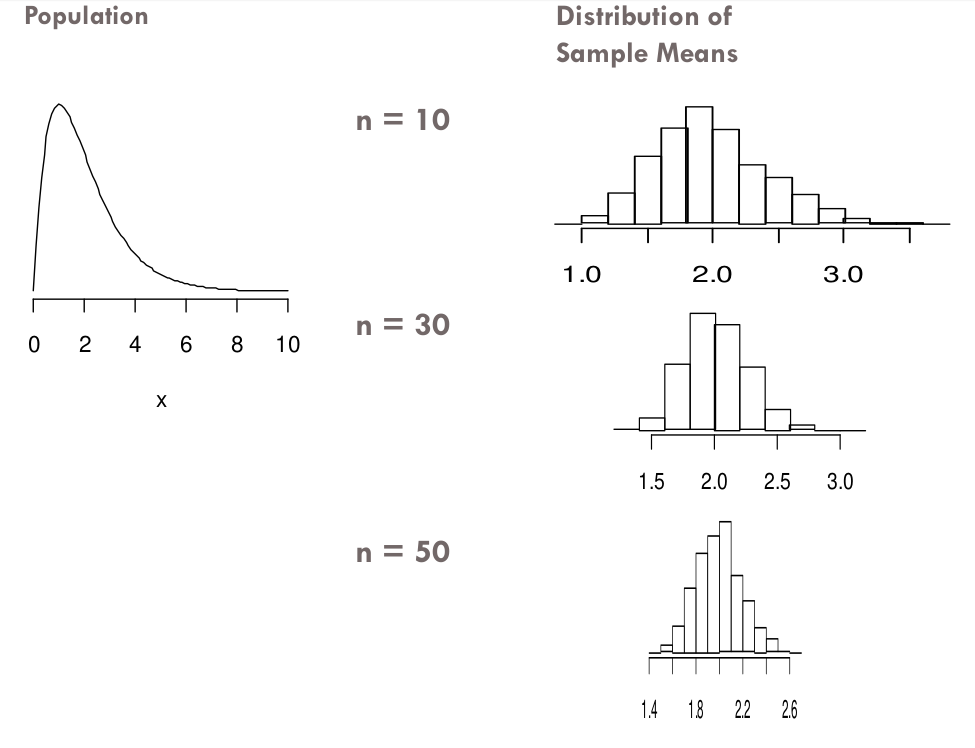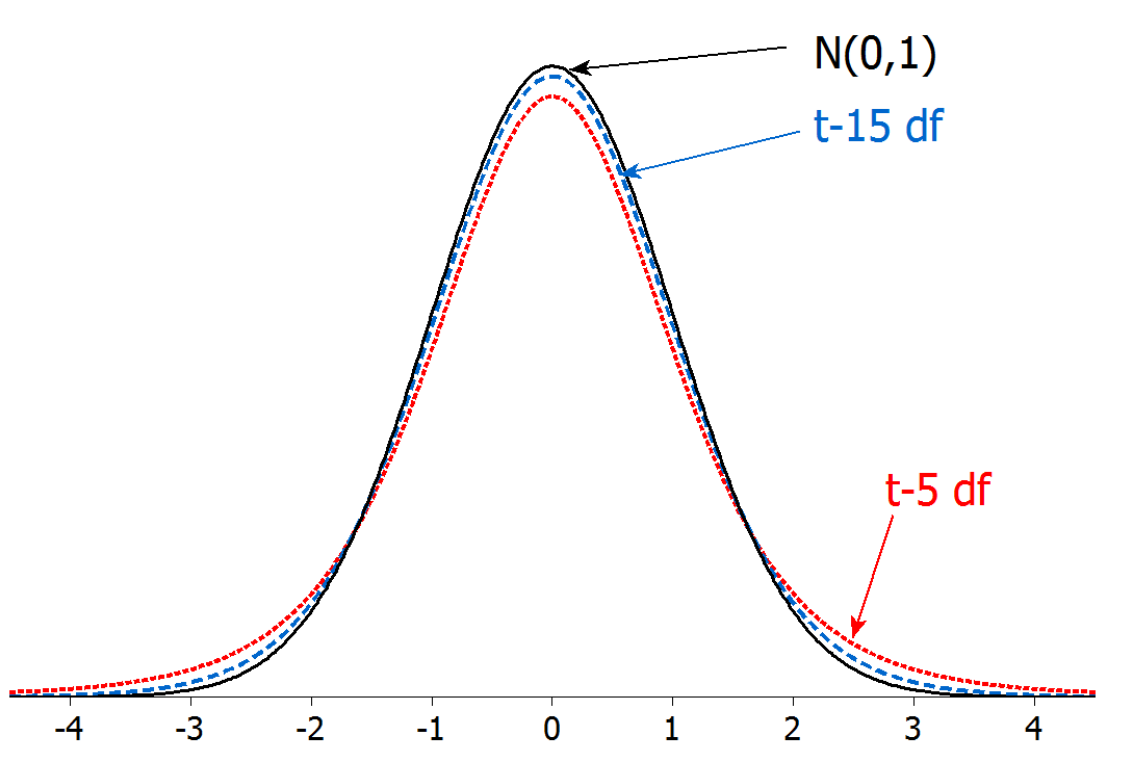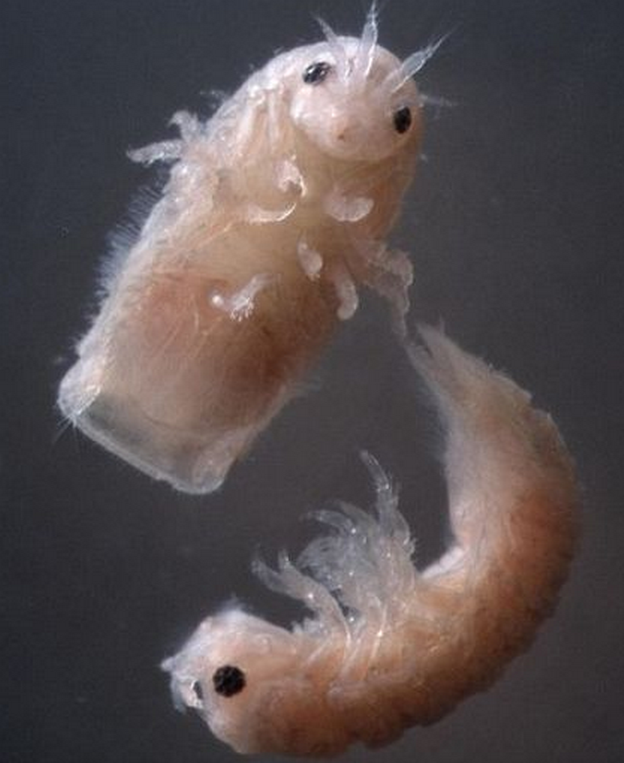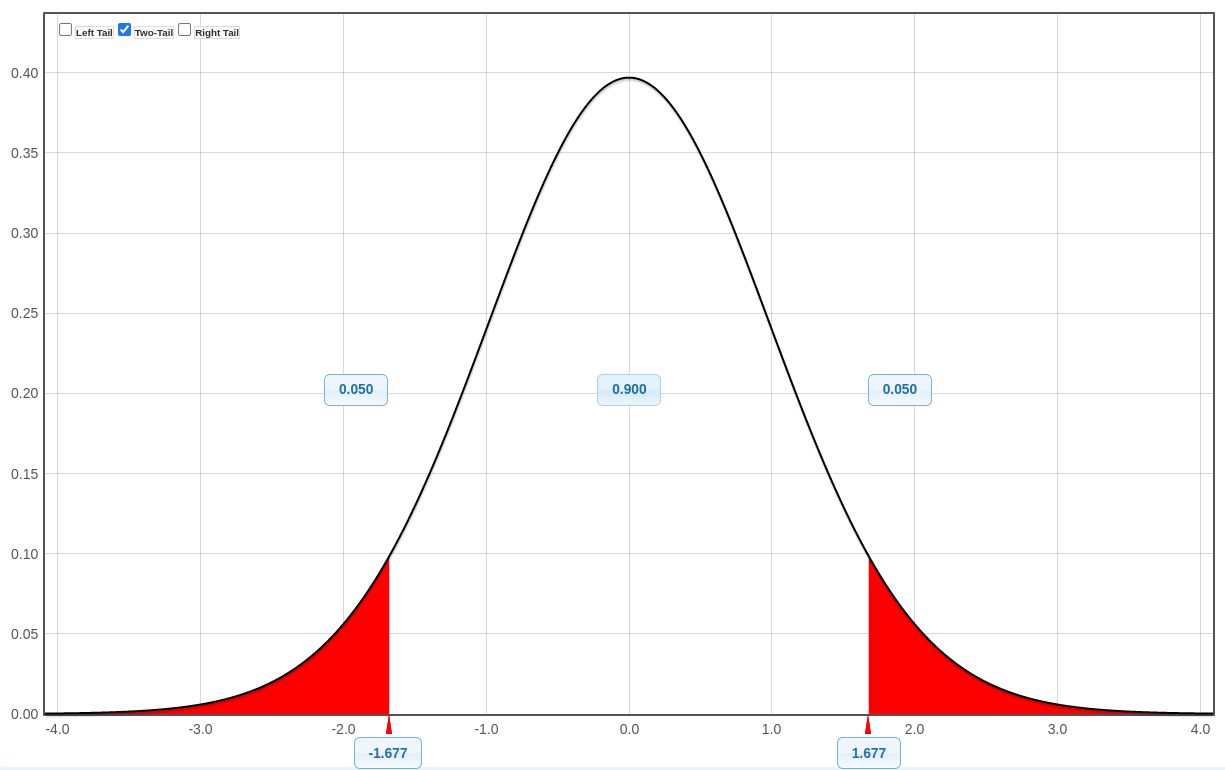
Inference for one mean
STAT 120
CLT for a Mean
If \(n \geq 30^*\), then
\[\bar{X} \approx N\left(\mu, \frac{\sigma}{\sqrt{n}}\right)\]
*Smaller sample sizes may be sufficient for symmetric distributions, and 30 may not be sufficient for very skewed distributions or distributions with high outliers
CLT for mean

Standard Deviation
The standard deviation of the population is
\(\sigma\)
\(s\)
\(\frac{\sigma}{\sqrt{n}}\)
Click for answer
The correct answer is a.Standard Deviation
The standard deviation of the sample is
- \(\sigma\)
- \(s\)
- \(\frac{\sigma}{\sqrt{n}}\)
Click for answer
The correct answer is b.Standard Deviation
The standard deviation of the sample mean is
- \(\sigma\)
- \(s\)
- \(\frac{\sigma}{\sqrt{n}}\)
Click for answer
The correct answer is c. The standard error is the standard deviation of the statistic.T-distribution
- Replacing \(\sigma\) with \(s\) changes the distribution of the z-statistic from a normal distribution to a t-distribution
- The \(t\) distribution is very similar to the standard normal, but with slightly fatter tails to reflect this added uncertainty
T-distribution

Inference for means: Hypothesis tests
Check: Check the one sample size conditions for the CLT
Tests: Use t-ratios of the form \[t=\frac{\text { stat }-\text { null value }}{S E}\] P-values computed from a t-distribution with appropriate \(\mathrm{df}\) - pt(t, df= ) gives the area to the left of \(t\)
Confidence intervals: \(\mathrm{CI}\) of the form \[\text { stat } \pm t^{*} S E\] The \(t^{*}\) multiplier comes from a t-distribution with appropriate \(d f\) - qt(0.975, df= ) gives \(t^{*}\) for \(95 \%\) confidence
Florida lakes
53 lakes were sampled, pH recorded
- Is average pH in Florida lakes different from 7 (neutral)?
- Let \(\mu\) be the mean pH for all Florida lakes \[H_0: \mu = 7 \qquad\qquad H_A: \mu \neq 7\]
Can we use a t-test?
- \(n=53\) is a decent sample size
- check sample distribution of pHs
Florida lakes
Florida lakes
\[H_0: \mu = 7 \qquad H_A: \mu \neq 7\] Data: The average pH was \(\bar{x}=6.591\) with a standard deviation of \(s=1.288\).
- The t-test stat is \(t = \dfrac{6.591 - 7}{1.288/\sqrt{53}} \approx -2.31\)
- Interpret t: The observed mean of 6.591 is 2.31 SEs below 7.
Florida lakes
\[H_0: \mu = 7 \qquad\qquad H_A: \mu \neq 7\] - p-value \(2 \times P(t < -2.31)\), or double left tail area below -2.31 - use t-distribution with \(df = 53-1= 52\)
Interpret: The p-value is 0.025. If the mean pH of all lakes is 7, then we would see a sample mean that is at least 2.31 SEs away from 7 about 2.5% of the time in samples of 53 lakes.
Conclusion: There is a statistically discernible difference between the observed mean pH of 6.591 and the hypothesized mean of 7 (t=-2.31, df=52, p=0.025).
Florida lakes: t.test in R
Florida lakes
How different is the population mean from 7?
- 95% CI for \(\mu\):
\[6.591 \pm 2.0066 \dfrac{1.288}{\sqrt{53}} = 6.591 \pm 0.355 = (6.236, 6.946)\] where \(t^*\) corresponds to 95% confidence (97.5th percentile):
We are 95% confident that the mean pH of all lakes is between 6.236 and 6.946 (slightly acidic)
Gribbles
Gribbles are small marine worms that bore through wood, and the enzyme they secrete may allow us to turn inedible wood and plant waste into biofuel
A sample of 50 gribbles finds an average length of \(3.1 \mathrm{~mm}\) with a standard deviation of \(0.72 \mathrm{~mm}\).
Give a \(90 \%\) confidence interval for the average length of gribbles.

Gribbles
A sample of 50 gribbles finds an average length of \(3.1 \mathrm{~mm}\) with a standard deviation of \(0.72 \mathrm{~mm}\). For a \(90 \%\) confidence interval for the average length of gribbles, what is \(t^*\) ?
a). 1.645 b). 1.677 c). 1.960 d). 1.690
Click for answer
\(d f=n-1=49 \text { and } t^*=1.677\)
Gribbles
A sample of 50 gribbles finds an average length of \(3.1 \mathrm{~mm}\) with a standard deviation of \(0.72 \mathrm{~mm}\). For a \(90 \%\) confidence interval for the average length of gribbles, what is the standard error?
a). 0.171 b). 0.720 c). 1.960 d). 0.102
Click for answer
\(\frac{s}{\sqrt{n}}=\frac{0.72}{\sqrt{50}}=0.102\)
Gribbles
A sample of 50 gribbles finds an average length of \(3.1 \mathrm{~mm}\) with a standard deviation of \(0.72 \mathrm{~mm}\). For a \(90 \%\) confidence interval for the average length of gribbles, what is the margin of error?
a). 0.171 b). 0.720 c). 1.960 d). 0.102
Click for answer
\(t^* \cdot \frac{s}{\sqrt{n}}=1.677 \cdot \frac{0.72}{\sqrt{50}}=0.171\)
Gribbles
\(\begin{gathered}\text { statistic } \pm t^* \cdot S E \\ \bar{x} \pm t^* \cdot \frac{s}{\sqrt{n}} \\ 3.1 \pm 1.677 \cdot \frac{0.72}{\sqrt{50}} \\ 3.1 \pm 0.17 \\ (2.93,3.27)\end{gathered}\)

We are \(90 \%\) confident that the average length of gribbles is between 2.93 and \(3.27 \mathrm{~mm}\).
Margin of error
\[\mathrm{CI}: \bar{x} \pm t^* \cdot \frac{s}{\sqrt{n}}\]
For a single mean, what is the margin of error?
- \(\frac{s}{\sqrt{n}}\)
- \(t^* \cdot \frac{s}{\sqrt{n}}\)
- \(2 \cdot \mathrm{t}^* \cdot \frac{s}{\sqrt{n}}\)